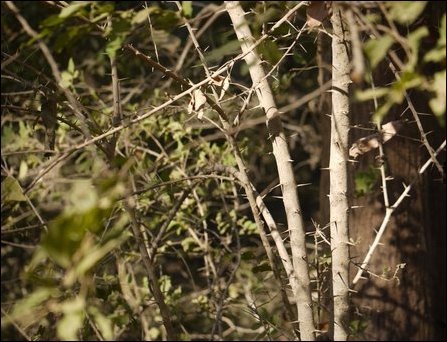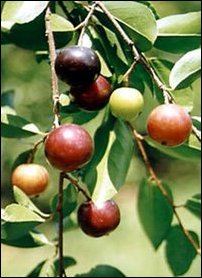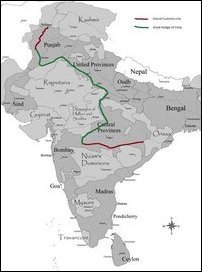Know the Etymology: 321
Place Name of the Day: Wednesday, 05 February 2014
Uguræssa-pitiya, Kiralæssa, Mal-læhæwa
உகு₃ரெ[æ]ஸ்ஸ-பி[ட்]டிய,
கிர-லெ[æ]ஸ்ஸ
மல்-லெ[æ]ஹெ[æ]வ
Uguræssa piṭiya
Kira-læssa
Mal-læhævaUguræssa+pitiya
Kira+læssa
Mal+læhæwa
The high ground plain of Uguræssa (live-hedge) bush
The thicket of parrots
The hilly thicket or bush-jungle
| Uguræssa |
A bushy shrub or tree with spiny trunk and branches, much favoured in making live fences, Indian plum, Sweet Lovilovi, Flacourtia indica, Flacourtia Ramontchi (Sinhala); Literally meaning 'the live-hedge multitude (bush)' or 'the mass or (thorn) traps'; Rata-uguræssa: Literally meaning the country Uguræssa, Flacourtia cataphracta (Sinhala); Cancali, Caricali; Flacourtia cataphracta (Kannada, DED 2292); Choththaik-ka'laa: Literally meaning the inferior type of Ka'laa, Flacoutia sepiaria, Ceylom plum, Flacourtia ramontchisapida, Lovolovi of Ceylon, Flacourtia inermis (Tamil, the latter two are identified as Ilangkai (Ceylon) trees (Tamil, MTL); See boxes below on Ugu and Ræssa
|
| Ugu |
1. Probably related to the meaning, live-hedge bush (Sinhala); Akula: Live hedge, grove, thicket, bushy place, bush, (Sinhala); Aakula: Crowded, filled with, confused (Sanskrit, CDIAL 1012); Samkula: Crowded together, dense (Sanskrit, CDIAL 12828); Saku'la: Numerous (Sinhala); 2. Probably related to the thorny or trapping attributes of the bush. Ugula: (singular), Ugul (plural): Snare, trap (Sinhala); Oggu: To lay a trap (Telugu, DED 934); Oggi, Uggi: Hook (Tulu, DED 5210); Ukir: Claw, finger nail, toe nail (Tamil, Malayalam, DED 561); Ugur: Nail, claw (Kannada, DED 561); Ugi: To hurt, tear, rend with nails; Ugurisu: To scratch asunder (Kannada, DED 561)
|
| Ræssa |
means a collection, multitude, a plant that grows collectively, bush, thicket or a place over-grown with jungle (Sinhala, place names); Ræs: multitude (Sinhala); Ræsa: multitude, company, collection (Sinhala); Ræha: multitude (Sinhala); Ræhe'niya: bush, thicket, place overgrown with jungle (Sinhala); Raasi: heap, a measure of quantity (Sanskrit, CDIAL 10720)
|
| Læssa |
seems to mean the same as Ræssa (R > L change, Sinhala, place names); Læhæba: thicket, bushy place, jungle (Sinhala). Pælæssa: a forest eco system; Pæl: plant, shrub; Læssa: multitude, thicket etc. (Sinhala place names). See box on Ræssa
|
| Læhæwa |
from Læhæba: thicket, bushy place, jungle (Sinhala); “Gulmaya, Gaswæl ghana va vædunu tæna”, (Sinhala, Sorata). See boxes on Læssa and Ræssa
|
| Kira |
also Girawaa: parrot (Sinhala); Keera: parrot (Sanskrit, Pali, Prakrit, CDIAL 3198); Ki'li, Ki'l'lai: parrot (Tamil, DED 1584); Cognates found in Malayalam, Kota, Toda, Kannada, Kodagu, Tulu, Telugu, Parji and Gadba (DED 1584, note the R/ L interchange).
|
| Pitiya |
plain tract of ground (Sinhala); usually a high ground plain, raised ground of a coast or bank (Sinhala place names); Piddi, Puddi, Thiddi, iddi, Chiddi: high ground, dune, mound, hillock, elevated plain, rising ground, raised ground, bank, sandbank, elevation, raised floor, (Tamil, DED 3221). See column on Kurumpachiddi for etymology.
|
| Mal |
combination form of Mala: hill (Sinhala); mountain (Malayalam, Telugu, DED 4742); Malai: hill, mountain (Tamil, DED 4742)
|
The components Ræssa and Læssa, coming in the Sinhala place names seem to be more or less synonyms (R/ L interchange), meaning a bush, thicket, jungle etc., or multitude of a plant that grows bushy and collectively.
In this context, note the related Sinhala words, Ræhe'niya and Læhæba meaning bush, thicket or place overgrown with jungle, and the Sinhala words, Ræs, Ræsa and Ræha meaning a multitude. The words are probably cognates of the Sanskrit/ Indo-Aryan term Raasi, meaning a heap (CDIAL 10720).
Certain plants that grow collectively into a thicket or as a bush also seem to have acquired the suffix Ræssa/ Læssa.
Other than the plant examples seen the place names listed below, there are also further examples such as Nil Monerassa, literally meaning the blue peacock multitude (Utricularia reticulate), Et Korassa wael, literally meaning the elephant grass multitude creepers (Tetracera akara) and Kandulæssa, meaning the hill bush (Drosera indica).
The Sinhala place name suffix Læhæwa is a variant of Læhæba, meaning a thicket, bushy place or dense jungle. In combinations the term comes only as Læhæ.
Note the R/L; S/ H; and B/ W interchanges in Ræssa, Læssa, Læhæba and Læhæwa

Flacourtia indica [Image courtesy: Dinesh Valke, flickr.com]

Flacourtia indica, fruits and foliage [Image courtesy: Medicinal Plants of Bangladesh]
Uguræssa is the Sinhala name for a thorny and bushy shrub or a small tree, botanically known as Flacourtia indica, or Flacourtia Ramontchi. Indian plum, Ceylon plum, Sweet Lovilovi are some of its names in English.
Flacourtia species are widely found in South Asia and they are believed to be native to the region. The Tamil name for Flacourtia is Choththaik-ka'laa, literally meaning an inferior type of Ka'laa, another thorny and bushy shrub. However, Madras Tamil Lexicon identifies Flacourtia Ramontchi and Flacourtia inermis as Ilangkai (Ceylon) varieties.
The fruit of Flacourtia indica or Uguræssa is sweet and acidic in taste. It could be eaten raw or could be made into jelly, jam, dried fruit etc. It is also used in making wine.
Noting on Flacourtia indica, a research paper by Indian academics appeared in International Journal of Research in Pharmaceutical and Biomedical Sciences, Vol 3 (1), Jan-Mar 2012, says the following:
“It is an indigenous medicinal plant widely distributed in Bangladesh and India. This plant has been reported as an answer for the treatment of a variety of diseases and functional disorder. Fruits are used as appetizing, diuretic, jaundice and enlarged spleen. Barks are used for the treatment of intermittent fever. Roots are used in nephritic colic and gum is used in cholera.”
“The pharmacological studies conformed the traditional uses of the Flacourtia indica as antioxidant, antimicrobial, anti asthamatic, anti diabetic, anti bacterial, anti inflamatory, anti malarial, hepatoprotective agent.”
During the early colonial rule of the English East India Company and the British Crown in India, Flacourtia indica was chosen as the main shrub to lay a living thorny fence across India, running into more than 1500 miles, to prevent native salt trade and to tax it. The fence that was exiting between 1840 and 1879 was called the “Indian Inland Customs Line.” It was compared to the Great Wall of China and was fetching huge revenue for the colonial empire.
As seen from the examples of place names or from the other plant names ending with Ræssa, the suffix Ræssa in Uguræssa seems to mean the bush-growing or multitude-growing nature of the plant.

The Indian Inland Customs Line. Marked in green was the live hedge, in which Flacourtia indica was largely used [Image courtesy: Wikipedia]
The prefix Ugu is perhaps related to another Sinhala word, Akula, meaning a live hedge, grove, thicket, bushy place or bush. Akula is probably a cognate of Aakula or Samkula in Sanskrit meaning crowded, dense etc. Also note the example of another Sinhala place name Aku-ræssa.
In another possibility, Ugu could have come from the trapping or thorny attribute of the bush. Ugula in Sinhala is a trap. The component Uku is used in some Sinhala phrases to mean a stake or hook as in Uku-nilla. Ukir/ Ugur means a nail or claw in Dravidian languages (DED 561).
* * *Kira in Sinhala and Giraawa in its colloquial usage, means a parrot. The words correspond to Keera in Sanskrit, Pali, Prakrit/ Indo-Aryan (CDIAL 3198) and Ki'li or Ki'l'lai in Tamil/ Dravidian (DED 1584), meaning the same. Note the R/ L interchange.
The Læssa suffix in the place name Kira-læssa is related to Ræssa and Læhæba in Sinhala, meaning a thicket, bushy place or jungle in this context.
See column on
Kurumpachiddi for etymological discussions on Pitiya meaning a high ground or raised land plain.
* * *Uguræssa-pitiya is in Harispattuwa division of Kandy district.
Kira-læssa is a village in Dambulla division of Matale district.
Mal-læhæwa is noticed as a place name in Mirigama division of Gampaha district and in Bibile division of Moneagala district.
* * *Some related place names:Ræssa:Heeressa-gala: The rocky hill of Heeræssa creepers; KFG&G Korale, Kandy district. Heeræssa: Climbing plant, with four winged stems, edible when tender and with red berries; Vitis Quadrangularis or Cissus quadrangularis (Sinhala)
Pupu-ressa: Probably, Pupul-ræssa: The thicket of Pupula (Vernonia zeylanica), a creeping plant peculiar to the island and abounds in the underwood or jungles; Doluwa division, Kandy district. Pupula: Kuppuzhai in Tamil
Aku-ressa: The place of live-hedge bush/ or the thicket or multitude of bushes/ or the multitude (of bushes) making a live hedge; Akuressa division, Matara district. Akula: Live hedge, grove, thicket, bushy place, bush, (Sinhala).
Wadu-ressa: The thicket of Waduru (the same as Heeræssa) climbing plant; or the thicket of Waduru-wæl, a species of Sun Flower; or the thicket of Wandulæssa plant; or the thicket of creepers; Ambanpola division, Kurunegala district; Nikaweratiya division, Kurunegala district; Kobeigane division, Kurunegala district. Wadula: place overgrown with creepers, natural arbour or bower (Sinhala)
Wandu-ressa: Probably, the thicket of Wandulæssa plant; Polpithigama division, Kurunegala district; Wariyapola division, Kurunegala district; Bingiriya division, Kurunegala district; Rideegama division, Kurunegala district. Wandulæssa: A plant, botanically unidentified (Sinhala, Clough)
* * *Læssa:Bora-lessa: The thicket of Bora shrubs; Milaniya division, Kalutara district; Wennapuwa division, Puththa'lam district
Gal-lassa: The rocky thicket; or the multitude of rocks; Kalutara division, Kalutara district
Meda-lassa Kalugamuwa: The dark (soil) village in the middle forest or thicket; or a combination of two village names, i.e., the middle forest and the dark (soil) village; Polgahawela division, Kurunegala district
* * *Læhæwa/ Læhæ:Uda-mal-læhæwa: The upper part of the hill thicket or forest; Bibile division, Moneragala district
Gal-læhæ-mulla: The corner of the rocky thicket; or the corner of the collection of rocks; Pannala division, Kurunegala district. Læhæn: Ræ’la (Sinhala, Sorata)
Gal-læhæra: The rocky thicket or the collection of rocks; Weerambugedera division, Kurunegala district. Læhæn: Ræ’la (Sinhala, Sorata)
Gal-læhæ-pitiya: The high ground plain of rocky thicket or collection of rocks; Panduwasnuwara East division, Kurunegala district. Læhæn: Ræ’la (Sinhala, Sorata)
* * *Kira:Kira-gala: The rocky hill of parrots; Kuruvita division, Ratnapura district
Kira-wana-gama: The village of parrot forest; Hildummulla division, Badulla district
Giraa:Gira-imbula: The parrot-green Imbul (silk cotton tree); or the Imbul (reminding) of the parrot (story); Hanwella division, Colombo district. Imbul fruit deceiving Parrots is a well-known adage in South Asian languages.
Gira-kaduwa: The jungle of parrots; Pathadumbara division, Kandy district
Gira-gama: The village of parrots; Yatinuwara division, Kandy district
Gira-ulla: The spring or waterhole of parrots; Ganga Ihala Korale division, Kandy district
Gira-thalana: The place of parrots; Panduwasnuwara division, Kurunegala district
Girambe: The (place of) parrot-nosed mango trees: Welimada division, Badulla district
Revised: Thursday, 18 February 2016, 19:29
First published: Wednesday, 05 February 2014, 19:25
Previous columns:










